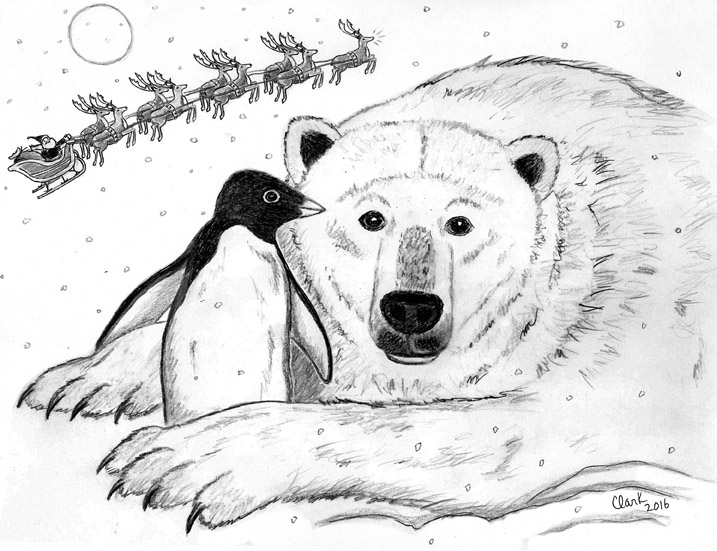
Dear Bird Folks,
Recently, I was shopping for Christmas cards when I came upon a box of nature cards. The scene showed polar bears and penguins cuddling on a snowy night. I bought the cards, but on the way home I remembered that penguins and polar bears don’t live anywhere near each other. Why would the card company make such a mistake?
– Judy, Truro, MA
IDK, Judy,
I can’t imagine why a card company would make such a blatant blunder. As a rule, Christmas cards are 100% accurate. Whether it’s images of angels, or wise men, or elves or Frosty (especially Frosty), they’re all based on facts (sort of). The only thing I question is Rudolph’s red nose. I’m a little concerned about that. My uncle often had a red nose and he wasn’t allowed to drive a car, let alone fly. I may have to speak to Santa about this.
The name “polar bear” fits this creature perfectly. These giant animals are found only around the North Pole (the same pole where Santa lives). Standing ten feet tall and weighing over 1,500 pounds, polar bears are the largest land carnivores in the entire world (followed closely by the Kodiak brown bear and George Foreman). Most creatures hate cold and snow, but polar bears love it. In fact, the female has her cubs in a den made out of snow and when the adults get hungry, they hunt on the ice. What do they eat? The polar bear’s diet is a combination of seals, seals and more seals. Occasionally, they will also grab a young walrus, chew on a dead whale or scarf down a few birds’ eggs (I don’t like to think about that last one), but mostly it’s all seals all the time. I was going to describe the clever way in which bears hunt for seals, but since this is a Christmas column, I’m going to refrain from sharing the unpleasant details. But I will tell you that 98% of the time the seals get away, so good for them. Also, studies have shown that the only seals that are actually caught are the bad seals. You know, the ones who have done something horrific in their lives, such as talking during a movie or working as a telemarketer. The bears can eat as many of those awful creatures as they want.
On the other side of the earth, in the Southern Hemisphere, there are no polar bears at all. Not one. But the Southern Hemisphere does have lots of delightful penguins. And because the areas in which penguins live are free of carnivorous polar bears and other terrestrial predators, the birds have lost their need to take flight. As a result, their wings have become flipper-like, which still allows them to “fly,” but only under water. (I think everyone knew that already, but since people continue to ask me if penguins are “real birds,” I can’t take anything for granted.)
What some folks don’t realize is that polar bears and penguins not only don’t share the same hemisphere, they typically don’t even require similar habitats. Only the Emperor Penguins (the stars of March of the Penguins) and the Adelie Penguins (one of the most adorable birds ever) breed in Antarctica. And only the Emperor Penguins raise their kids in the snow, polar bear style. The rest of the penguins (another fifteen species) are found in more temperate, or even hot locations. The most abundant species, the Macaroni Penguin (real name), has a population in excess of twelve million, with some of them breeding along the coast of not-so-snowy Africa. FYI: Macaroni Penguins received their delicious-sounding name from the early British explorers. Macaroni Penguins have ornate yellow head plumes and these flamboyant feathers reminded the explores of the fashion trendsetters back in Britain, which were called “macaronis” for some reason. Thus the song lyrics: “Stuck a feather in his cap and called it…” Hey, for the first time in my life that song actually makes sense. On second thought, it still doesn’t.
Twenty-eight years ago, when my daughter was born, my wife and I did what most new parents do with a ten-week-old infant; we took her on a trip to New Zealand. She wanted to see NZ’s birds and visit the homes of the Hobbits (or perhaps that was just me). One day, while driving along a coastal road, we stopped to photograph a field of sheep. (Sheep in New Zealand? What a surprise.) As I waded through the green grass, I noticed a pair of eyes watching me, and they didn’t belong to a sheep. Ten feet away, standing in front of a burrow, was a penguin. What? There was no snow or ice anywhere. It was seventy degrees and I was in the middle of a sheep field, a quarter of a mile from the ocean. I would have been less surprised to see a Hobbit. The burrow was the “home” of a rare Yellow-eyed Penguin, which, like most of its relatives, isn’t into the whole ice and snow thing. Instead, this penguin prefers to nest in coastal forests, which, sadly, have been transformed into pastures for sheep. Darn sheep (but they are still cute).
I don’t know what to tell you about Christmas cards portraying polar bears cuddling with penguins, Judy. I guess the card people are trying to create a feel-good image and aren’t depicting a true nature scene. They are merely sending the message that on Christmas we ought to have good thoughts towards everyone, and I agree. Well, towards everyone except the people who talk during a movie or work as telemarketers. Even Christmas can’t save them.